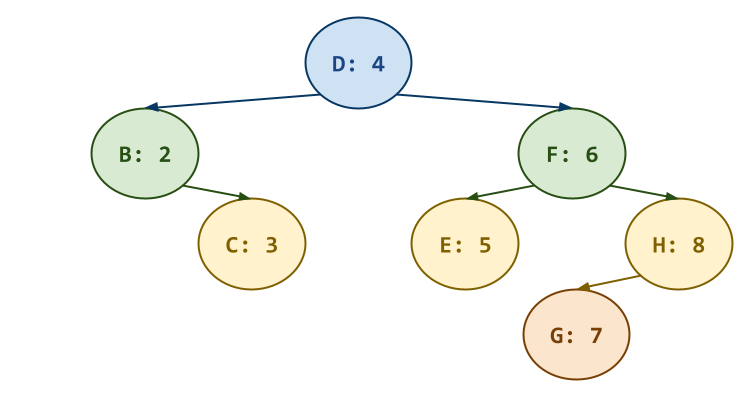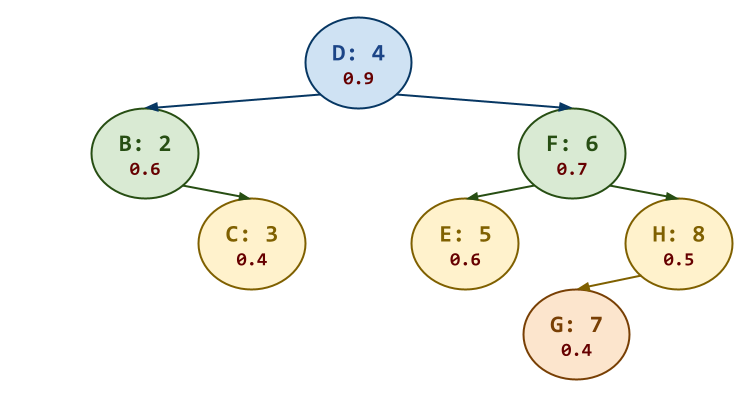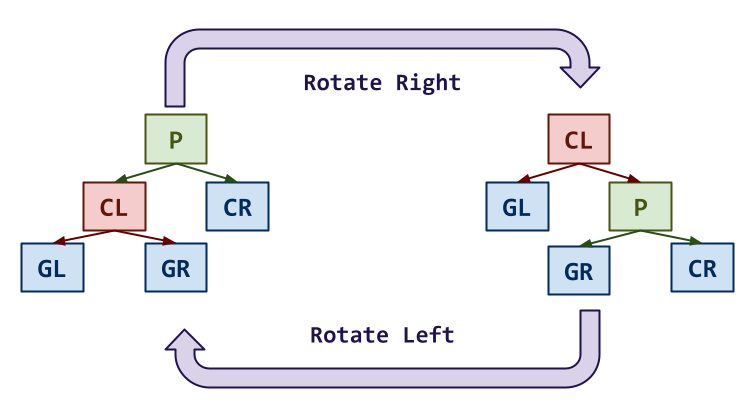Homework 11: Binary Search Trees, Treaps
The goal of this homework assignment is to allow you to explore building binary search trees and treaps in order to implement a map in Python. Once you have these data structures implemented, you will employ them to solve a programming challenge that involves determining if two words are anagrams.

For this assignment, you are to do your work in the homework11 folder of
your assignments GitHub repository and push your work by noon,
Wednesday, November 22.
Activity 0: Preparation¶
Before starting this homework assignment, you should first perform a git
pull to retrieve any changes in your remote GitHub repository:
$ cd path/to/repository # Go to assignments repository
$ git switch master # Make sure we are in master branch
$ git pull --rebase # Get any remote changes not present locally
Next, create a new branch for this assignment:
$ git checkout -b homework11 # Create homework11 branch and check it out
Task 1: Skeleton Code¶
To help you get started, the instructor has provided you with the following skeleton code:
# Go to assignments repository
$ cd path/to/assignments/repository
# -----------------------------------------------------
# MAKE SURE YOU ARE NOT INSIDE THE homework11 DIRECTORY
# -----------------------------------------------------
# MAKE SURE YOU ARE AT THE TOP-LEVEL DIRECTORY
# -----------------------------------------------------
# Download skeleton code tarball
$ curl -LO https://www3.nd.edu/~pbui/teaching/cse.20312.fa23/static/tar/homework11.tar.gz
# Extract skeleton code tarball
$ tar xzvf homework11.tar.gz
Once downloaded and extracted, you should see the following files in your
homework11 directory:
homework11
\_ Makefile # This is the Makefile for building all the assignment artifacts
\_ anagrams.py # This is the Python script for the Anagrams script
\_ bst.py # This is the Python module for the Binary Search Tree module
\_ treap.py # This is the Python module for the Treap module
Task 2: Initial Import¶
Now that the files are extracted into the homework11 folder, you can
commit them to your git repository:
# Go into homework11 folder
$ cd homework11
# Add and commit initial skeleton files
$ git add Makefile # Mark changes for commit
$ git add *.py
$ git commit -m "Homework 11: Initial Import" # Record changes
Task 3: Unit Tests¶
After downloading and extracting these files, you can run the make command
to run the tests.
# Run all tests (will trigger automatic download)
$ make
You will notice that the Makefile downloads three additional test scripts:
homework11
\_ anagrams_test.py # This is the Python unit test for the Anagrams script
\_ bst_test.py # This is the Python unit test for the Binary Search Tree module
\_ treap_test.py # This is the Python unit test for the Treap module
In addition to the embedded doctests in the skeleton code, you will be using these unit tests to verify the correctness and behavior of your code.
Automatic Downloads¶
The test scripts are automatically downloaded by the Makefile, so any
modifications you do to them will be lost when you run make again.
Likewise, because they are automatically downloaded, you do not need to add
or commit them to your git repository.
The details on what you need to implement for this assignment are described in the following sections.
Activity 1: Binary Search Tree (5 Points)¶
For the first activity, you are to utilize our usual Node dataclass to
implement a binary search tree class called BST:
@dataclass
class Node:
key: str
value: int = 0
priority: float = 0
left: Optional['Node'] = None
right: Optional['Node'] = None
Because you will be using the BST as a map, each Node has a key,
value, and priority, in addition to links to the left and right
Nodes.
Invariants¶
Remember that you must maintain the binary search tree invariants for
the key attribute:
-
Each
Nodeis never less than everyNodein its left subtree. -
Each
Nodeis always less than everyNodein its right subtree.
To make the new BST class look and feel like a normal dict in Python,
you will be implementing various magic methods such as __contains__
(ie. key in d), __getitem__, (ie. d[key]), and __setitem__ (ie.
d[key] = value), in addition to internal recursive methods for
searching and inserting into the binary search tree.
Task 1: bst.py¶
The bst.py Python script contains the BST class you are to complete for
this activity:
-
_search(self, node: Optional[Node], key: str) -> boolThis method recursively searches for the specified
keyin the internal binary search tree starting from the givennodeand returnsTrueif thekeyis found, otherwseFalse.Hint: Use divide-and-conquer and carefully consider your base cases. -
__contains__(self, key: str) -> boolThis magic method returns
Trueif the specifiedkeyis in the internal binary search tree, otherwiseFalse(ie.key in bst).Hint: UseBST._search. -
_lookup(self, node: Optional[Node], key: str) -> intThis method recursively searches for the specified
keyin the internal binary search tree starting from the givennodeand returns the associated value if thekeyis found, otherwse it raises aKeyError.Hint: Use divide-and-conquer and carefully consider your base cases. -
__getitem__(self, key: str) -> intThis magic method returns the associated value if the specified
keyis in the internal binary search tree, otherwise it raises aKeyError(ie.bst[key]).Hint: UseBST._lookup. -
get(self, key, default=None) -> intThis method returns the associated value if the specified
keyis in the internal binary search tree, otherwise returns thedefaultvalue (ie.bst.get(key, default)).Hint: Use atry/exceptwithBST._lookup. -
_insert(self, node: Optional[Node], key: str, value: int) -> NodeThis method recursively inserts the specified
keyandvalueinto the internal binary search tree starting from the givennode. If aNodewith the specifiedkeyis already in the binary search tree, then update thevalue.Hint: Use divide-and-conquer and carefully consider your base cases. -
__setitem__(self, key: str, value: int) -> NoneThis magic method sets or updates the associated value of the specified
keyin the internal binary search tree (ie.bst[key] = value).Hint: UseBST._insert. -
_walk(self, node: Optional[Node]) -> Iterator[tuple[str, int]]This method recursively generates tuples of the key, value pairs in the internal binary search tree in sorted order starting from the given
node. -
items(self) -> Iterator[tuple[str, int]]This method recursively generates tuples of the key, value pairs in the internal binary search tree in sorted order.
Hint: UseBST._walk.
DocTests¶
You may notice that in addition to the usual comments and TODOs, the docstrings of each method also contains a few doctests.
You are not to modify these doctests and must keep them in-place. They are used to verify the correctness of your code.
Your code goes below the docstrings, where the TODO and pass commands are (you may remove the pass once you complete the method).
Task 2: Testing¶
As you implement bst.py, you can use the provided doctests to verify the
correctness of your code:
# Run doctests
$ python3 -m doctest bst.py -v
...
9 items passed all tests:
3 tests in bst.BST.__contains__
3 tests in bst.BST.__getitem__
5 tests in bst.BST.__setitem__
2 tests in bst.BST._insert
3 tests in bst.BST._lookup
3 tests in bst.BST._search
2 tests in bst.BST._walk
3 tests in bst.BST.get
2 tests in bst.BST.items
26 tests in 18 items.
26 passed and 0 failed.
Test passed.
You can also use make to run both the doctests and the unit tests:
# Run unit tests (and doctests)
$ make test-bst
Testing bst ...
test_00_doctest (__main__.BSTTests) ... ok
test_01_mypy (__main__.BSTTests) ... ok
test_02_search (__main__.BSTTests) ... ok
test_03_contains (__main__.BSTTests) ... ok
test_04_lookup (__main__.BSTTests) ... ok
test_05_getitem (__main__.BSTTests) ... ok
test_06_get (__main__.BSTTests) ... ok
test_07_insert (__main__.BSTTests) ... ok
test_08_setitem (__main__.BSTTests) ... ok
test_09_walk (__main__.BSTTests) ... ok
test_10_items (__main__.BSTTests) ... ok
Score 5.00 / 5.00
Status Success
----------------------------------------------------------------------
Ran 11 tests in 0.051s
OK
To just run the unit tests, you can do the following:
# Run unit tests
$ ./bst_test.py -v
...
To run a specific unit test, you can specify the method name:
# Run only mypy unit test
$ ./bst_test.py -v BSTTests.test_01_mypy
...
Iterative Development¶
You should practice iterative development. That is, rather than writing a bunch of code and then debugging it all at once, you should concentrate on one function at a time and then test that one thing at a time. The provided unit tests allow you to check on the correctness of the individual functions without implementing everything at once. Take advantage of this and build one thing at a time.
Activity 2: Treap (2 Points)¶
For the second activity, you are to implement a treap class based on the previous binary search tree class.

Because a treap is a fundamentally a binary search tree with the addition
of a priority attribute that is used to maintain a max heap
invariant, you will be able to inherit most of the methods from the
BST class in Activity 1 and only need to implement a new _insert
method for the Treap class (along with two utility static methods).
Task 1: treap.py¶
The treap.py Python script contains the Treap class you are to complete
for this activity:

-
_rotate_left(p) -> NodeThis static method rotates the specified
Nodepto the left as shown above and returns the new root of the sub-tree.Hint: Study and draw pictures. Be sure to move account for the middle child. -
_rotate_right(p) -> NodeThis static method rotates the specified
Nodepto the right as shown above and returns the new root of the sub-tree.Hint: Study and draw pictures. Be sure to move account for the middle child. -
_insert(self, node: Optional[Node], key: str, value: int, priority: Optional[float]=0) -> NodeThis method recursively inserts the specified
keyandvalueinto the internal treap starting from the givennode. If aNodewith the specifiedkeyis already in the treap, then update thevalue. If thepriorityis not specified, then userandom()to generate one.Hints¶
-
Use divide-and-conquer and carefully consider your base cases.
-
Use a logical
orto handle thepriority. -
Use
Treap._rotate_leftandTreap._rotate_rightto balance the treap when appropriate.
-
Task 2: Testing¶
As you implement treap.py, you can use the provided doctests to verify
the correctness of your code:
# Run doctests
$ python3 -m doctest treap.py -v
...
3 items passed all tests:
3 tests in treap.Treap._insert
2 tests in treap.Treap._rotate_left
2 tests in treap.Treap._rotate_right
7 tests in 5 items.
7 passed and 0 failed.
Test passed.
You can also use make to run both the doctests and the unit tests:
# Run unit tests (and doctests)
$ make test-treap
Testing treap ...
test_00_doctest (__main__.TreapTests) ... ok
test_01_mypy (__main__.TreapTests) ... ok
test_02_rotate_left (__main__.TreapTests) ... ok
test_03_rotate_right (__main__.TreapTests) ... ok
test_04_insert (__main__.TreapTests) ... ok
test_05_setitem (__main__.TreapTests) ... ok
Score 3.00 / 3.00
Status Success
----------------------------------------------------------------------
Ran 6 tests in 0.051s
OK
To just run the unit tests, you can do the following:
# Run unit tests
$ ./treap_test.py -v
...
To run a specific unit test, you can specify the method name:
# Run only mypy unit test
$ ./treap_test.py -v TreapTests.test_01_mypy
...
Activity 3: Anagrams (3 Points)¶
For this activity, you are to use your Treap implementation of a map to
solve the following programming challenge:
Given two words, determine if they are anagrams (ignoring capitalization), which are pairs of words where one word can be formed by rearranging the letters in the other word.
For instance, "secure" is an anagram of "rescue".
Here is a demonstration of the anagrams.py script in action:
$ ./anagrams.py
secure rescue
secure and rescue are anagrams!
Anna NaaN
Anna and NaaN are anagrams!
taco cat
taco and cat are not anagrams!
Task 1: anagrams.py¶
For this task, you are to complete the anagrams.py Python script by
implementing the following functions:
-
count_letters(s: str) -> TreapThis function counts all the occurrences of each letter in
sand returns aTreapwith the counts. -
is_anagram(word1: str, word2: str) -> boolThis function returns whether or not
word1andword2are anagrams (ignoring capitalization).Hint: Usecount_letterson each word and compare the counts. -
main(stream=sys.stdin) -> NoneThis function reads in a pair of words on each line, determines if they are anagrams, and then prints the result.
Hint: Useis_anagram.
Task 2: Testing¶
As you implement anagrams.py, you can use the provided doctests to verify
the correctness of your code:
# Run doctests
$ python3 -m doctest anagrams.py -v
3 items passed all tests:
1 tests in anagrams.count_letters
2 tests in anagrams.is_anagram
2 tests in anagrams.main
5 tests in 4 items.
5 passed and 0 failed.
Test passed
You can also use make to run both the doctests and the unit tests:
# Run unit tests (and doctests)
$ make test-anagrams
Testing anagrams ...
test_00_doctest (__main__.AnagramsTests) ... ok
test_01_mypy (__main__.AnagramsTests) ... ok
test_02_count_letters (__main__.AnagramsTests) ... ok
test_03_is_anagram (__main__.AnagramsTests) ... ok
test_04_main (__main__.AnagramsTests) ... ok
Score 2.00 / 2.00
Status Success
----------------------------------------------------------------------
Ran 5 tests in 0.050s
OK
To just run the unit tests, you can do the following:
# Run unit tests
$ ./anagrams_test.py -v
...
To run a specific unit test, you can specify the method name:
# Run only mypy unit test
$ ./anagrams_test.py -v AnagramsTests.test_01_mypy
...
Activity 4: Quiz (2 Points)¶
Once you have completed all the activities above, you are to complete the following reflection quiz:
As with Reading 01, you will need to store your answers in a
homework11/answers.json file. You can use the form above to generate the
contents of this file, or you can write the JSON by hand.
To check your quiz directly, you can use the check.py script:
$ ../.scripts/check.py
Checking homework11 quiz ...
Q1 0.80
Q2 0.40
Q3 0.40
Q4 0.40
Score 2.00 / 2.00
Status Success
Leet Point (1 Extra Credit Point)¶
For extra credit, you are to solve the following LeetCode problem in Python.
To receive credit, you must pass on LeetCode and achieve an Accepted submission.
Verification¶
To get credit for this Leet Point, show your solution and the LeetCode acceptance page to a TA to verify (or attached a screenshot with both to your Pull Request). You have up until two days after this assignment is due to verify your Leet Point.
Self-Service Extension¶
Remember that you can always forgo this Leet Point for two extra days to do the homework. That is, if you need an extension, you can simply skip the Leet Point and you will automatically have until Friday to complete the assignment for full credit.
Just leave a note on your Pull Request of your intentions.
Submission¶
To submit your assignment, please commit your work to the homework11 folder
of your homework11 branch in your assignments GitHub repository:
#-----------------------------------------------------------------------
# Make sure you have already completed Activity 0: Preparation
#-----------------------------------------------------------------------
...
$ git add bst.py # Mark changes for commit
$ git commit -m "Homework 11: Activity 1" # Record changes
...
$ git add treap.py # Mark changes for commit
$ git commit -m "Homework 11: Activity 2" # Record changes
...
$ git add anagrams.py # Mark changes for commit
$ git commit -m "Homework 11: Activity 3" # Record changes
...
$ git add answers.json # Mark changes for commit
$ git commit -m "Homework 11: Activity 4" # Record changes
...
$ git push -u origin homework11 # Push branch to GitHub
Pull Request¶
Remember to create a Pull Request and assign the appropriate TA from the Reading 12 TA List.
DO NOT MERGE your own Pull Request. The TAs use open Pull Requests to keep track of which assignments to grade. Closing them yourself will cause a delay in grading and confuse the TAs.